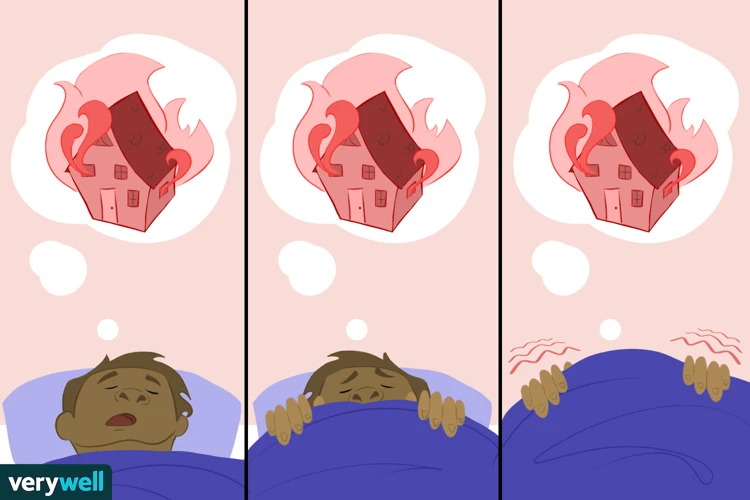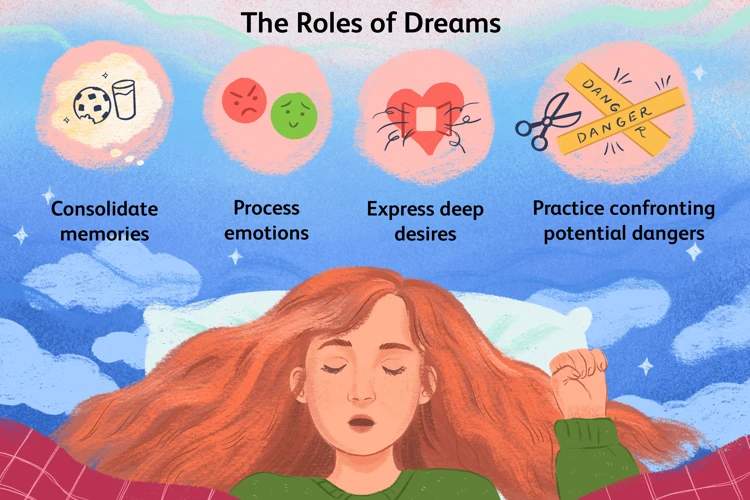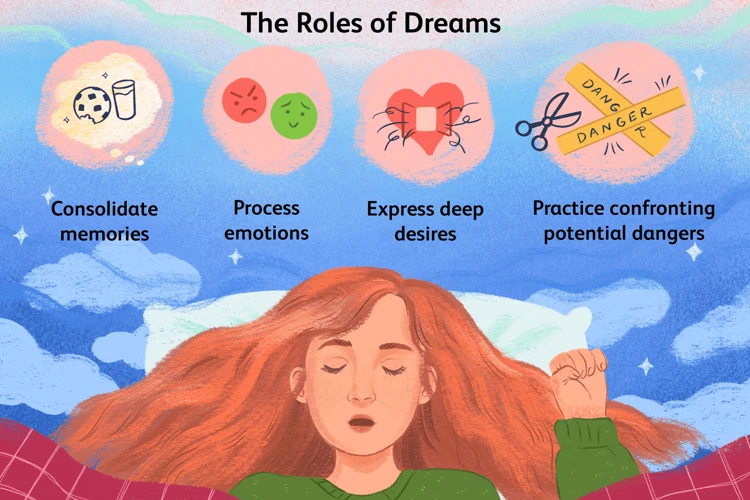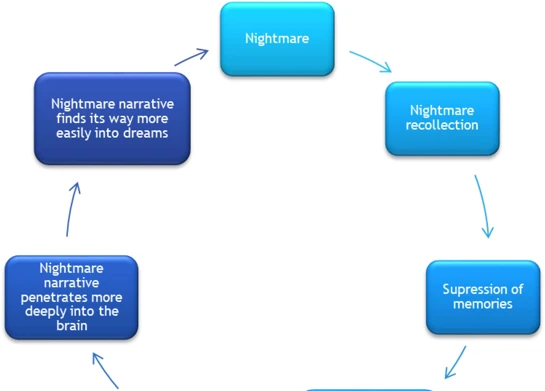Nightmares and Trauma: Unraveling the Mysterious Connection
Have you ever awoken from a terrifying dream, heart pounding and drenched in sweat? Nightmares can be distressing, but did you know they could also play a crucial role in processing trauma? Trauma is a complex and deeply rooted experience that can leave lasting emotional scars. In this article, we delve into the fascinating interplay between nightmares and trauma, exploring their connection and uncovering their purpose. Join us as we unravel this mysterious relationship and discover the benefits nightmares can offer in the healing journey. So, fasten your seatbelt and get ready for a mind-bending exploration of the role of nightmares in processing trauma.
Understanding Trauma

Trauma is a profound and complex psychological experience that can have long-lasting effects on an individual’s well-being. Understanding Trauma requires a deep exploration of its definition and the various types of traumatic experiences that individuals may encounter. Trauma, commonly defined as a response to an overwhelming event or series of events, can result from experiences such as physical or sexual abuse, natural disasters, accidents, or witnessing violence. It is essential to recognize that trauma affects individuals differently, and the extent of its impact can vary based on factors such as resilience, support systems, and personal coping mechanisms. Developing an understanding of trauma is the first step in comprehending the connection between nightmares and the healing process.
Definition of Trauma
Understanding the definition of trauma is vital in comprehending its impact on an individual’s mental and emotional well-being. Trauma is generally described as a psychological response to an overwhelmingly distressing event or series of events. It can result from various sources, including war, physical or sexual abuse, natural disasters, accidents, or witnessing violence. Traumatic events can shatter an individual’s sense of safety, trust, and control over their own well-being. They can lead to a range of emotional, cognitive, and physical symptoms such as anxiety, intrusive thoughts, nightmares, flashbacks, hypervigilance, and emotional numbing. Trauma is a deeply personal experience, and its effects can vary widely from person to person. It is crucial to acknowledge and validate an individual’s unique response to trauma in order to provide them with the necessary support and resources for healing and recovery. If you’re interested in learning more about how to prevent nightmares that can be triggered by trauma, check out our helpful guide on preventing nightmares. Additionally, for tips on coping with nightmares, you can refer to our comprehensive resource of recommended nightly tips.
Types of Traumatic Experiences
Understanding the different types of traumatic experiences is crucial in grasping the breadth and complexity of trauma. Trauma can stem from various events, each leaving its own unique imprint on an individual’s psyche. Here are some common types of traumatic experiences:
- Physical Trauma: This type of trauma arises from experiences involving bodily harm or injury. It can include incidents such as accidents, physical assaults, or medical procedures.
- Sexual Trauma: Sexual trauma refers to any non-consensual or unwanted sexual experience. It encompasses sexual abuse, assault, harassment, or rape, and can cause profound and long-lasting emotional effects.
- Emotional Trauma: Emotional trauma is often the result of prolonged exposure to highly distressing or overwhelming situations. This can include experiences such as ongoing domestic violence, emotional neglect, or severe bullying.
- Psychological Trauma: Psychological trauma encompasses experiences that threaten an individual’s cognitive and emotional well-being. This can include witnessing or being involved in a traumatic event, such as a natural disaster, terrorist attack, or major accident.
- Complex Trauma: Complex trauma refers to prolonged and repetitive experiences of trauma, often occurring during childhood. It can involve a combination of physical, sexual, emotional, or psychological abuse and neglect, typically within the context of relationships.
It is important to understand that these are just a few examples, and the spectrum of traumatic experiences is vast. Each person’s trauma is unique, and the impact can vary greatly from one individual to another. Recognizing and acknowledging the different types of traumatic experiences is essential in providing support and understanding to those who have endured such events.
Nightmares as Manifestations of Trauma

Nightmares, manifestations of trauma, are intense and disturbing dreams that can occur during sleep. These unsettling experiences often involve vivid and realistic scenarios that evoke feelings of fear, helplessness, or distress. Nightmares can serve as a reflection of unresolved trauma, where the mind tries to make sense of and process the traumatic event. They may contain elements or triggers related to the trauma, replaying the distressing situation or emotions associated with it. Nightmares can be recurrent, causing recurring distress and disrupting sleep patterns, contributing to a cycle of psychological distress for individuals who have experienced trauma. Understanding the connection between nightmares and trauma is vital in addressing their impact on an individual’s mental well-being and facilitating healing.
What are Nightmares?
Nightmares are vivid and distressing dreams that can evoke strong negative emotions, intense fear, and a sense of impending danger. These dreams often involve scenarios that are disturbing, threatening, or surreal. While it is common for individuals to experience occasional nightmares, they can become more prevalent and disruptive for those who have undergone traumatic experiences. Nightmares tend to occur during Rapid Eye Movement (REM) sleep, a stage of sleep associated with increased brain activity and vivid dreaming. During nightmares, individuals may wake up feeling a range of physical sensations, such as an increased heart rate, sweating, and a heightened state of alertness. It is important to note that nightmares are different from regular dreams, as they can cause considerable distress and can linger in one’s mind even after waking up. Understanding the nature of nightmares is crucial in examining their role in processing trauma and exploring ways to address their impact on individuals’ overall well-being.
Link between Trauma and Nightmares
The is a complex and intertwined one. Nightmares often serve as a reflection of unresolved trauma, making them an integral part of the healing process. When an individual experiences a traumatic event, the brain attempts to process and make sense of the intense emotions, sensations, and memories associated with it. However, these experiences can become fragmented and fragmented, leading to unresolved trauma. This unresolved trauma can manifest in nightmares, which act as a means for the subconscious mind to bring forth and process the traumatic experiences in a symbolic and metaphorical way.
Nightmares related to trauma are characterized by vivid, distressing, and often repetitive dreams that evoke intense fear, helplessness, or anxiety. These dreams may involve re-experiencing the traumatic event itself or elements associated with it. They can provoke strong emotional and somatic reactions, causing individuals to wake up feeling terrified, overwhelmed, and disoriented.
The link between trauma and nightmares lies in the way the brain tries to process and integrate fragmented memories, emotions, and sensations associated with the traumatic event. Nightmares serve as a mechanism for the mind to make sense of these experiences and bring them to consciousness for processing. In a way, nightmares act as a defense mechanism, attempting to bring attention to unresolved trauma and facilitate its healing.
It is important to note that not everyone who experiences trauma will develop nightmares. The occurrence of nightmares varies from person to person, influenced by factors such as the severity of the trauma, individual coping mechanisms, and the presence of pre-existing mental health conditions.
Understanding the link between trauma and nightmares is crucial in recognizing the significance of nightmares as indicators of unresolved trauma. By acknowledging the connection, individuals can seek appropriate support and therapeutic interventions to address and heal from their traumatic experiences.
Purpose of Nightmares in Processing Trauma

Nightmares serve a unique purpose in the processing of trauma, providing a profound avenue for emotional release, symbolic representation, and memory integration. These unsettling dreams can act as a catalyst for catharsis, allowing individuals to release pent-up emotions and confront unresolved feelings related to their traumatic experiences. Through vivid and often terrifying imagery, nightmares offer a symbolic representation of the trauma, allowing the dreamer to explore and make sense of their emotions in a metaphorical context. Additionally, nightmares play a vital role in reconstructing fragmented memories, helping the individual integrate and make meaning out of their traumatic experiences. By understanding the purpose of nightmares in trauma processing, individuals can navigate this intricate journey of healing with greater clarity and insight.
Emotional Release and Catharsis
Emotional release and catharsis play a vital role in the purpose of nightmares when it comes to processing trauma. Nightmares provide a powerful outlet for individuals to release pent-up emotions and unresolved feelings related to their traumatic experiences. When we dream, our subconscious mind has the opportunity to express and process emotions that may be too overwhelming or repressed in our waking lives. Nightmares can serve as a safe container for these intense emotions to surface, allowing individuals to confront and release them in a controlled environment.
During a nightmare, the dreamer may experience intense fear, sadness, anger, or a combination of these emotions, triggering a cathartic release. The vivid and immersive nature of nightmares often amplifies these emotional experiences, allowing individuals to fully engage with their feelings. This release can help relieve emotional tension, freeing individuals from the burden of carrying unresolved emotions associated with their trauma.
Nightmares can serve as a catalyst for cathartic healing journeys. By experiencing the intensity of emotions within the dream world, individuals can gain a deeper understanding of the impact of their trauma and begin the process of emotional integration and growth. This emotional release and catharsis provide an opportunity for individuals to heal and move forward in their journey of trauma recovery.
Let’s now explore another key purpose of nightmares in processing trauma – symbolic representation and metaphor.
Symbolic Representation and Metaphor
Symbolic representation and metaphor play a significant role in the purpose of nightmares in processing trauma. When we experience a traumatic event, our mind may struggle to make sense of the overwhelming emotions and fragmented memories associated with it. Nightmares, with their vivid and often bizarre imagery, provide a unique opportunity for our subconscious mind to symbolically represent and process these unresolved emotions and memories.
In nightmares, symbols and metaphors are often used to depict the deep-rooted fears, conflicts, and unresolved issues related to the traumatic experience. These symbols may take the form of monsters, dark shadows, or familiar figures undergoing distressing scenarios. The symbolic nature of nightmares allows the mind to express and explore complex emotions that may be too overwhelming to process in waking life.
Through symbolic representation, nightmares facilitate the exploration of repressed or disassociated emotions. These symbols act as metaphors, providing a safe distance between the dreamer and the traumatic experience, allowing for a gradual and controlled confrontation of the underlying issues. By transforming the raw emotions into symbolic imagery, the mind can gradually make sense of the trauma, integrate the fragmented memories, and initiate the healing process.
It is important to note that decoding the symbolism in nightmares can be subjective, as the meaning of symbols may vary from person to person. What may represent fear for one individual may signify something entirely different for another. Exploring and understanding the personal significance of symbols in nightmares becomes crucial in unraveling the underlying messages and emotions connected to the trauma.
Symbolic representation and metaphor serve as powerful tools within nightmares, enabling the mind to process and make meaning of traumatic experiences. By utilizing symbols, dreams allow for the exploration and expression of complex emotions, ultimately aiding in the healing journey of trauma survivors.
Reconstructing Memories and Integration
Traumatic experiences often fragment memories, making it challenging to process and integrate the events into one’s narrative. Nightmares can serve as a powerful tool in the reconstruction of these fragmented memories. During nightmares, the mind attempts to make sense of the traumatic experience, creating vivid and intense imagery that reflects the emotional impact of the event. These nightmares can bring suppressed memories to the surface, providing an opportunity to explore and confront the trauma in a controlled environment.
By experiencing and engaging with these nightmares, individuals can gradually piece together the fragments of their memories, forming a cohesive narrative. This process of reconstructing memories allows for a deeper understanding of the traumatic event and its associated emotions. It enables individuals to make connections between past experiences and present emotions, facilitating the integration of these fragmented memories into their overall life story.
Integration of memories is crucial for healing from trauma, as it helps individuals create a coherent sense of self and a more comprehensive understanding of their experiences. Through the nightmares, individuals can confront the emotions and beliefs associated with the traumatic event, leading to a gradual resolution and acceptance. This integration process can be challenging and emotionally charged but ultimately promotes personal growth and resilience.
It’s important to note that reconstructing memories and integrating them through nightmares should be approached with care and support. Professional assistance, such as therapy or counseling, can provide guidance and tools to navigate this challenging terrain. Creating a safe and supportive environment is essential to ensure the healing process is effective and empowering.
Nightmares play a significant role in reconstructing memories and integrating them into an individual’s narrative. They offer an opportunity to explore the emotions attached to the trauma, make connections, and ultimately foster a sense of healing and personal growth.
Benefits of Nightmares in Healing

Nightmares, despite their horror and discomfort, serve a significant purpose in the healing process. can be witnessed through various ways. Firstly, nightmares facilitate emotional processing by allowing individuals to confront and release intense emotions associated with their trauma. This release serves as a cathartic experience, providing a much-needed outlet for pent-up emotions. Secondly, nightmares provide a safe space for exploration, allowing individuals to confront their fears and anxieties in the realm of dreams, where they can experiment with different scenarios and outcomes without real-life consequences. This exploration fosters a sense of empowerment and resilience. Lastly, nightmares offer symbolic representation and metaphorical expressions, aiding in the reconstruction of memories and the integration of fragmented aspects of the traumatic event. Through these benefits, nightmares play a crucial role in the healing journey, promoting understanding, growth, and recovery.
Facilitating Emotional Processing
Facilitating Emotional Processing
1. Increased Awareness: Nightmares serve as a wake-up call, bringing unresolved emotions and memories to the forefront of the mind. They act as a catalyst, forcing individuals to confront and acknowledge difficult emotions associated with their trauma. The vivid and intense nature of nightmares heightens emotional awareness, providing an opportunity for individuals to delve deeper into their emotional landscape.
2. Emotional Release: Nightmares offer a safe space for emotional release, allowing individuals to express and process their pent-up feelings. The vivid imagery and intense emotions experienced during nightmares can help release suppressed emotions, reducing emotional distress in waking life. This release can provide a sense of catharsis and relief, enabling individuals to move towards healing and growth.
3. Integration of Experiences: Nightmares can aid in integrating fragmented memories and experiences associated with trauma. They serve as a bridge between conscious and unconscious realms, allowing the mind to piece together fragments of the traumatic event. By providing symbolic representations and metaphors, nightmares help individuals grasp and understand their experiences on a deeper level. This integrated understanding promotes coherence and a sense of closure, facilitating emotional processing.
4. Identification of Triggers and Themes: Recurring themes and triggers within nightmares can offer valuable insights into unresolved trauma. By analyzing the content of their nightmares, individuals can identify patterns, triggers, and underlying themes related to their trauma. This newfound awareness helps individuals gain a deeper understanding of their trauma and the factors influencing their emotional responses. It empowers them to develop coping strategies and seek appropriate support.
Emotional processing is a vital component of trauma recovery, and nightmares play an integral role in this process. By facilitating increased awareness, emotional release, integration of experiences, and identification of triggers and themes, nightmares offer a unique opportunity for individuals to engage in deep emotional healing and growth.
Providing a Safe Space for Exploration
Providing a safe space for exploration is a crucial benefit of nightmares in the healing process. Nightmares often present vivid and intense scenarios that mirror the distressing experiences associated with trauma. However, within the realm of dreams, individuals have an opportunity to navigate these scenarios in a controlled environment, offering a sense of safety and control that may be lacking in their waking lives. In the safety of their own minds, individuals can confront their fears, confront the trauma they have experienced, and process their emotions at their own pace. This safe space allows for the exploration of complex feelings, thoughts, and memories, fostering a deeper understanding of the trauma’s impact and enabling healing to occur. By confronting their nightmares and delving into the emotions and symbolism they contain, individuals can start to unravel the layers of trauma that may have been buried deep within. This process of exploration can be challenging and emotionally stimulating, but it ultimately allows individuals to engage with their trauma in a controlled and supportive environment, leading to increased self-awareness and healing.
Empowering the Dreamer
Nightmares can be incredibly distressing experiences, often leaving the dreamer feeling powerless and overwhelmed. However, they also have the potential to empower the dreamer in various ways. Through the process of exploring and understanding their nightmares, individuals can reclaim a sense of control and agency over their traumatic experiences. By actively engaging with their dreams, they can begin to unravel the symbolism and hidden meanings embedded within these unsettling visions.
One way nightmares empower the dreamer is by providing an opportunity for self-reflection and personal growth. As individuals confront their fears, anxieties, and traumas within the dream realm, they may find the strength to face these challenges in waking life. The vivid and intense nature of nightmares often compels individuals to confront uncomfortable emotions head-on, fostering resilience and inner strength.
Additionally, nightmares can serve as catalysts for change and transformation. By unraveling the symbolic messages within their dreams, individuals can gain valuable insights into their traumas and their own inner psyche. These insights can spark profound personal growth, leading to increased self-awareness, healing, and ultimately, empowerment.
Empowering the dreamer also involves recognizing the role of choice and agency in dream exploration. Individuals can proactively embark on the journey of dream interpretation and engage in techniques such as lucid dreaming or dream incubation to gain a greater sense of control over their dreams. This active participation allows individuals to shape their dream narratives and navigate their traumatic experiences within the dream realm.
Nightmares have the potential to empower the dreamer by providing opportunities for self-reflection, personal growth, and transformation. By actively engaging with their nightmares and understanding the symbolism within, individuals can reclaim control over their traumatic experiences, foster resilience, and embark on a path towards healing and empowerment.
Strategies for Working with Nightmares

When it comes to working with nightmares, there are several effective strategies that can help individuals navigate these distressing experiences. One powerful technique is to keep a dream journal. By recording and reflecting on dreams, individuals can gain insight into recurring themes, emotions, and symbols within their nightmares. Another valuable approach is the use of therapeutic techniques for nightmares, such as imagery rehearsal therapy or lucid dreaming, which can empower individuals to confront and alter the course of their nightmares. Seeking professional help is also highly recommended, as therapists specializing in trauma and dreamwork can provide guidance, support, and evidence-based interventions to assist individuals in overcoming nightmares. By implementing these strategies, individuals can take proactive steps toward transforming their nightmares and reclaiming their peace of mind.
Keeping a Dream Journal
Keeping a Dream Journal can be a powerful tool in processing trauma-related nightmares. This practice involves recording details of your dreams immediately upon waking. By keeping a dream journal, you create a personal archive of your dream experiences that can provide valuable insights into the underlying emotions and themes associated with your trauma. Writing down your dreams allows you to capture the vivid imagery, intense emotions, and symbolic representations that often accompany nightmares. Additionally, a dream journal provides a safe space to express and explore your feelings related to the trauma. When reviewing your dream entries over time, you may start to notice patterns, recurring symbols, or key themes that can provide valuable clues about your healing journey. The act of journaling itself can also be cathartic, helping to release intense emotions associated with trauma. Consider using a dedicated notebook or a digital journaling app to keep your dream journal organized and easily accessible. By engaging in this practice, you empower yourself to take an active role in understanding and processing your nightmares, leading to potential breakthroughs in healing and personal growth.
Therapeutic Techniques for Nightmares
Therapeutic techniques for nightmares are aimed at addressing the distressing and recurring nature of these experiences, as well as helping individuals find relief and healing. Here are some approaches and strategies used by professionals in the field:
1. Imagery Rehearsal Therapy (IRT): This technique involves revisiting and altering the content of the nightmare through visualization and mental rehearsal. It allows individuals to create a new and positive outcome for the dream, reducing the distress associated with it.
2. Cognitive Behavioral Therapy (CBT): CBT focuses on identifying and challenging negative thought patterns related to the nightmare. By replacing irrational beliefs with more realistic ones, individuals can reframe their perception of the dream and reduce anxiety.
3. Eye Movement Desensitization and Reprocessing (EMDR): EMDR is a therapeutic approach commonly used for trauma-related nightmares. It involves eye movements or other forms of bilateral stimulation to process and reframe traumatic memories, which can help alleviate nightmares.
4. Sleep Hygiene Practices: Implementing healthy sleep habits can contribute to reducing the frequency and intensity of nightmares. This includes creating a calming bedtime routine, maintaining a consistent sleep schedule, avoiding stimulating substances like caffeine or alcohol before bed, and creating a comfortable sleep environment.
5. Relaxation Techniques: Various relaxation techniques, such as deep breathing, progressive muscle relaxation, or guided imagery, can help individuals manage stress and anxiety associated with nightmares. These practices promote relaxation and improve sleep quality.
6. Mindfulness and Meditation: Mindfulness-based techniques, such as meditation and mindfulness exercises, can aid in developing a non-judgmental awareness of the present moment. This can help individuals cultivate a sense of calmness and reduce the emotional impact of nightmares.
7. Medication: In some cases, medications may be prescribed to manage nightmares, especially if they are interfering with daily life or causing significant distress. These medications can help regulate sleep patterns and decrease the frequency or intensity of nightmares.
It’s important to note that therapeutic techniques for nightmares should be implemented under the guidance and supervision of a qualified mental health professional. They will assess the individual’s specific needs and develop a personalized treatment plan to address the nightmares effectively.
Seeking Professional Help
In the journey of healing from trauma and navigating the complexities of nightmares, seeking professional help can be an invaluable step. Mental health professionals, such as therapists and counselors, are extensively trained in understanding the intricacies of trauma and can provide specialized interventions and support. They can offer a safe and non-judgmental space for individuals to explore their experiences, process emotions, and develop effective coping strategies. These professionals have a wealth of knowledge and experience in working with trauma-related nightmares, allowing them to guide individuals through the healing process. Therapeutic techniques, such as Cognitive Behavioral Therapy (CBT) and Eye Movement Desensitization and Reprocessing (EMDR), are often employed to address trauma and related nightmares. Mental health professionals can help individuals develop a comprehensive treatment plan tailored to their specific needs, ensuring personalized care and support. It is important to remember that seeking professional help is not a sign of weakness but rather a courageous step towards healing and reclaiming one’s well-being.
Dream Interpretation and Support

When it comes to navigating the intricate realm of dreams, interpretation and support are vital in making sense of the messages our unconscious mind is trying to convey. involve exploring symbolism and themes that emerge in our dreams, offering valuable insights into the hidden meanings behind our nightmares. By keeping a dream journal and documenting the details of our dreams, we can start to recognize recurring symbols or patterns that may hold significance. Seeking guidance from supportive networks, such as friends, family, or support groups, can provide a safe space to share our dreams and gain different perspectives. Additionally, various therapy models, such as psychoanalysis or cognitive-behavioral therapy, offer professional support in understanding the deeper meaning of our dreams and their connection to our trauma. By embracing dream interpretation and seeking support, we embark on a journey of self-discovery and healing that can lead to profound insights and personal growth.
Exploring Symbolism and Themes
When it comes to exploring symbolism and themes in nightmares, it is crucial to approach them with curiosity and an open mind. Nightmares often contain vivid and intense imagery that may seem confusing or disturbing at first glance. However, these symbols and themes serve as an essential gateway to understanding the underlying emotions and experiences associated with trauma.
Each element in a nightmare, whether it be objects, people, or situations, can hold significant symbolic meaning. For example, a recurring theme of being trapped or pursued may represent a sense of powerlessness or unresolved fear in the waking life of the individual. By investigating these symbols further, dreamers can gain valuable insights into their subconscious perceptions and emotions related to their traumatic experiences.
One effective technique for exploring symbolism and themes is keeping a dream journal. This involves recording the details of the nightmares as soon as one wakes up, capturing as much detail as possible. This process helps in identifying patterns, recurring imagery, and emotional reactions that can provide clues to the underlying trauma.
Additionally, seeking the assistance of a skilled therapist or dream analyst can be immensely helpful in navigating the complex symbolism within nightmares. These professionals can provide guidance in deciphering the underlying messages and themes, offering a deeper understanding of the trauma and facilitating the healing process.
It is important to approach the exploration of symbolism and themes in nightmares with a non-judgmental and compassionate mindset. Each individual’s experience is unique, and the symbols and themes within their nightmares hold personal significance. By delving deep into these symbolic elements, individuals can uncover hidden meanings, gain self-awareness, and empower themselves on their journey to healing from trauma.
Supportive Networks and Therapy Models
When it comes to overcoming nightmares and trauma, having a strong support network and access to appropriate therapy models is crucial. Supportive networks can provide individuals with a safe space to share their experiences, express their emotions, and receive validation and understanding. Whether it be friends, family members, support groups, or online communities, having people who genuinely listen and offer support can make a significant difference in the healing process. Additionally, therapy models tailored specifically to trauma and nightmares can provide invaluable guidance and tools for overcoming these experiences. Therapies such as cognitive-behavioral therapy (CBT), eye movement desensitization and reprocessing (EMDR), and narrative therapy have been shown to be effective in helping individuals process and heal from trauma-related nightmares. These therapy models aim to address the underlying trauma, reframe negative beliefs, develop coping strategies, and promote resilience and recovery. Seeking professional help from therapists trained in trauma-focused interventions can greatly assist individuals in navigating their nightmares and trauma, ultimately leading to a path of healing and restoration. Remember, you don’t have to face nightmares and trauma alone – reach out to your support network and explore therapy options for the support you deserve.
Overcoming Nightmares and Trauma
Overcoming nightmares and trauma requires a multi-faceted approach that focuses on self-care, rebuilding safety and trust, and accessing professional treatment options. Tools for self-care and coping play a crucial role in managing the distress caused by nightmares and trauma. These can include practices such as mindfulness, relaxation techniques, exercise, and maintaining a consistent sleep routine. Creating a safe and supportive environment is essential, whether it involves enhancing personal safety measures, seeking support from loved ones, or joining support groups. Rebuilding safety and trust involves working through the effects of trauma, building resilience, and learning to trust oneself and others again. It may involve therapy modalities such as cognitive-behavioral therapy (CBT), eye movement desensitization and reprocessing (EMDR), or trauma-focused therapy. Seeking professional treatment options is crucial for individuals struggling with severe or persistent nightmares and trauma. Trained therapists can provide trauma-specific interventions, guide individuals through the recovery process, and offer a safe space for healing. Remember that overcoming nightmares and trauma is a journey that requires patience, support, and a willingness to engage in the healing process.
Tools for Self-Care and Coping
Self-care and coping are crucial aspects of healing from trauma and managing nightmares. Let’s explore some tools that can be beneficial for individuals in their journey towards recovery:
1. Establish a Self-Care Routine: Creating a consistent self-care routine can provide a sense of stability and comfort. This may include activities such as practicing mindfulness or meditation, engaging in physical exercise, maintaining a healthy diet, getting enough restful sleep, and nurturing social connections.
2. Utilize Relaxation Techniques: Relaxation techniques can help reduce stress and anxiety associated with trauma and nightmares. Deep breathing exercises, progressive muscle relaxation, guided imagery, and aromatherapy are some effective techniques that can promote relaxation and emotional well-being.
3. Engage in Expressive Arts: Engaging in creative outlets, such as painting, writing, or playing music, can serve as a therapeutic form of self-expression. Expressive arts allow individuals to communicate and process their emotions in a non-verbal way, providing a sense of release and empowerment.
4. Practice Grounding Techniques: Grounding techniques help individuals anchor themselves in the present moment and manage distressing emotions and physical sensations. Examples of grounding techniques include focusing on the sensations of the body, using grounding objects or images, or engaging in mindful activities such as gardening or knitting.
5. Seek Support: Building a strong support system is vital for self-care and coping. Reach out to trusted friends, family members, or support groups who can provide a listening ear, understanding, and validation. Consider joining support groups specifically tailored to trauma survivors or individuals experiencing nightmares.
6. Engage in Professional Therapy: Seeking professional help from therapists experienced in trauma and anxiety can provide valuable support and guidance. Therapeutic approaches such as cognitive-behavioral therapy (CBT), eye movement desensitization and reprocessing (EMDR), or dialectical behavior therapy (DBT) can help individuals process trauma, manage nightmares, and develop healthy coping strategies.
Remember, everyone’s healing journey is unique, and it may take time to find the most effective tools for your self-care and coping. Be patient with yourself and allow space for experimentation to discover what works best for you.
Rebuilding Safety and Trust
Recovering from trauma involves the arduous process of rebuilding a sense of safety and trust, both within oneself and in the world. Traumatic experiences can shatter one’s belief in the predictability and stability of life, leaving individuals feeling vulnerable and fearful. To begin the journey of rebuilding safety and trust, it is crucial to create a supportive and secure environment. This can involve seeking out trustworthy and empathetic individuals, such as friends, family, or therapists, who can provide a safe space for the survivor to express their emotions without judgment or blame.
Building trust with oneself is just as important. This entails listening to one’s own needs and boundaries, honoring them, and gradually expanding comfort zones. Engaging in self-care practices that promote a sense of safety and nurturing can significantly aid in rebuilding trust. These practices may include developing a consistent routine, engaging in relaxation techniques like deep breathing or meditation, and engaging in activities that promote positive emotions, such as hobbies or spending time in nature.
Additionally, therapy can be immensely helpful in the process of rebuilding safety and trust. Therapists specializing in trauma work can provide valuable support and guidance, helping individuals navigate the challenges of trust-building. Techniques like cognitive-behavioral therapy (CBT) and Eye Movement Desensitization and Reprocessing (EMDR) can be employed to address trauma-related trust issues and enhance feelings of safety. These therapeutic approaches assist individuals in reframing negative beliefs about themselves and the world, and gradually replacing them with more positive and realistic ones.
Ultimately, rebuilding safety and trust is a gradual and individualized process. It requires patience, self-compassion, and a commitment to personal growth. By actively cultivating a safe and supportive environment, both internally and externally, individuals can embark on a journey towards healing and reclaiming their sense of security and trust in themselves and the world around them.
Professional Treatment Options
When it comes to addressing trauma-related nightmares, seeking professional treatment options can provide crucial support and guidance. Mental health professionals specializing in trauma therapy can offer evidence-based interventions tailored to individual needs. One effective treatment approach is Cognitive Behavioral Therapy (CBT), which aims to identify and challenge negative thought patterns and behaviors. CBT techniques, including exposure therapy and cognitive restructuring, can help individuals revisit and reframe traumatic memories, reducing the intensity and frequency of nightmares. Eye Movement Desensitization and Reprocessing (EMDR) is another commonly used therapy specifically designed for trauma-related symptoms. EMDR involves bilateral stimulation, such as eye movements or tapping, to facilitate the processing and integration of distressing memories. Additionally, other therapeutic modalities, such as psychodynamic therapy, somatic experiencing, and art therapy, may be utilized to explore the underlying emotions and experiences contributing to trauma-related nightmares. It is essential to consult with a qualified professional to determine which treatment approach is most appropriate for addressing trauma and its associated nightmares. Remember, professional support can play a pivotal role in the journey towards healing and reclaiming a sense of peace and well-being.
Conclusion
In conclusion, understanding the role of nightmares in processing trauma is crucial for individuals seeking healing and recovery. Nightmares serve as manifestations of unresolved trauma, offering an avenue for emotional release, symbolic representation, and memory integration. While nightmares can be distressing, they play a beneficial role in facilitating emotional processing, providing a safe space for exploration, and empowering the dreamer. Strategies such as keeping a dream journal, utilizing therapeutic techniques, and seeking professional help can aid in working with nightmares effectively. Dream interpretation and support from supportive networks and therapy models can further enhance the healing process. Overcoming nightmares and trauma requires tools for self-care, rebuilding safety and trust, and seeking professional treatment options when necessary. By acknowledging the significance of nightmares and their connection to trauma, individuals can embark on a journey towards healing, resilience, and renewed well-being.
Frequently Asked Questions
How do traumatic experiences affect the human brain?
Traumatic experiences can have profound effects on the human brain. They can disrupt normal brain functioning, leading to changes in areas responsible for memory, emotions, and stress responses.
What are some common symptoms of trauma?
Common symptoms of trauma can include flashbacks, nightmares, intrusive thoughts, hypervigilance, avoidance behaviors, mood swings, difficulty concentrating, and physical symptoms like headaches or stomachaches.
Why do some individuals experience nightmares after a traumatic event?
Nightmares can be a manifestation of the trauma experienced. They occur as the brain tries to process and make sense of the distressing memories and emotions associated with the traumatic event.
Can nightmares cause additional trauma?
Nightmares themselves do not directly cause additional trauma, but they can exacerbate and retraumatize individuals by reawakening intense emotions and fears associated with the initial traumatic experience.
How can nightmares be beneficial in the healing process?
Nightmares can serve as a means of emotional release and catharsis, symbolic representation and metaphor, and reconstructing memories and integrating fragmented experiences, all of which contribute to the healing and processing of trauma.
What are some strategies for coping with nightmares?
Strategies for coping with nightmares include keeping a dream journal, engaging in relaxation techniques before sleep, practicing grounding exercises upon waking, and seeking professional help if the nightmares become overwhelming.
Are there therapy techniques specifically designed to address nightmares?
Yes, there are therapy techniques, such as imagery rehearsal therapy (IRT) and exposure therapy, that specifically target nightmares and help individuals reframe and process traumatic experiences associated with them.
Can dreams and nightmares be interpreted to gain insight into trauma?
Yes, dream and nightmare interpretation can provide valuable insight into the underlying themes, emotions, and symbolism related to trauma. It can assist individuals in uncovering hidden aspects of their experiences and promoting healing.
How can social support networks help individuals dealing with trauma and nightmares?
Supportive networks can provide a safe space for individuals to share their experiences, offer empathy and understanding, and connect them with resources and professionals who specialize in trauma and nightmares, fostering a sense of belonging and validation.
Can professional treatment help individuals overcome nightmares and trauma?
Yes, professional treatment options, including therapy modalities such as cognitive-behavioral therapy (CBT) and eye movement desensitization and reprocessing (EMDR), can assist individuals in overcoming nightmares and processing trauma in a safe and guided environment.








